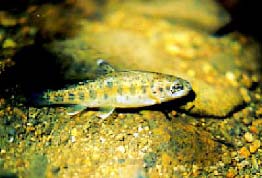| Forest Road Drainage Installation Practices | |
| in the Pacific Northwest | |
| 10 - Fisheries Issues | Fisheries Windows, Fish Passage |

If the installation of a drainage structure in a fish stream requires instream work, work should be scheduled for an "Instream Reduced Risk Window" commonly referred to as a fisheries window. However, windows (see table of Reduced Risk Windows) indicate only when instream work is least likely to adversely impact fish. Therefore, site-specific precautions such as fish removal or silt fencing may still be required even within the fisheries windows. Be sure to use the correct window for your operating area. A local agency representative such as a habitat officer may vary timing windows to reflect local conditions.
When instream work with fish on site or close by is required outside the fisheries window, a detailed installation plan should be prepared for agency approval. The plan should include fish removal from the work site, and possibly a stream diversion plan to ensure that water quality will not be jeopardized through sediment transport. The Sediment Triangle suggests that a simple and very effective way to minimize sediment generation is dewatering the stream channel. Diversion dams allow the installation of drainage structures in dry streambeds, and better compaction of bedding materials.
As a rule, if a structure protects fish habitat, then fish passage will not normally be an issue. The population and distribution of fish species, the quality of fish habitat, the timing of the proposed works and the proposed installation practices are all factors that the fisheries agencies must consider during the authorization process. These factors influence the decision whether a closed-bottom structure such as a pipe or pipe arch will be suitable to protect fish habitat.
Always check with local authorities for design and authorization requirements for crossings in fish streams, and follow the applicable construction specifications during the structure installation.
Historic failures of structures are frequently the result of poor installation practices. Failures should not necessarily be blamed on the type of structure chosen. Proper installation practices are essential for any structure chosen and should be modified only after discussions with the designer. Learn from past mistakes such as:
| 10 - Fisheries Issues |
| Next |
||
| PLANNING ISSUES |
INSTALLATION PRACTICES
|
|
©1999 - 2001 Flip Productions Limited Used with permission by CulvertBC |